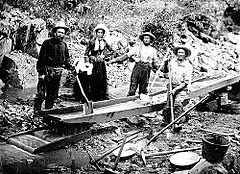
Back حمى ذهب كاليفورنيا Arabic Fiebre del oru de California AST Kaliforniya qızıl hərisliyi Azerbaijani Калифорнийска златна треска Bulgarian Febre de l'or de Califòrnia Catalan Kalifornská zlatá horečka Czech Guldfeberen i Californien Danish Kalifornischer Goldrausch German Kalifornia deliro pri oro Esperanto Fiebre del oro de California Spanish
 Prospectors working California gold placer deposits in 1850 | |
| Date | January 24, 1848–1855 |
|---|---|
| Location | Sierra Nevada and Northern California goldfields |
| Coordinates | 38°48′1″N 120°53′32″W / 38.80028°N 120.89222°W |
| Participants | 300,000 prospectors |
| Outcome | California becomes a US state California genocide occurs |
| This article is part of a series on the |
| History of the United States |
|---|
 |
The California gold rush (1848–1855) was a gold rush that began on January 24, 1848, when gold was found by James W. Marshall at Sutter's Mill in Coloma, California.[1] The news of gold brought approximately 300,000 people to California from the rest of the United States and abroad.[2] The sudden influx of gold into the money supply reinvigorated the American economy; the sudden population increase allowed California to go rapidly to statehood in the Compromise of 1850. The gold rush had severe effects on Native Californians and accelerated the Native American population's decline from disease, starvation, and the California genocide.
The effects of the gold rush were substantial. Whole indigenous societies were attacked and pushed off their lands by the gold-seekers, called "forty-niners" (referring to 1849, the peak year for gold rush immigration). Outside of California, the first to arrive were from Oregon, the Sandwich Islands (Hawaii), and Latin America in late 1848. Of the approximately 300,000 people who came to California during the gold rush, about half arrived by sea and half came overland on the California Trail and the California Road; forty-niners often faced substantial hardships on the trip. While most of the newly arrived were Americans, the gold rush attracted thousands from Latin America, Europe, Australia, and China. Agriculture and ranching expanded throughout the state to meet the needs of the settlers. San Francisco grew from a small settlement of about 200 residents in 1846 to a boomtown of about 36,000 by 1852. Roads, churches, schools and other towns were built throughout California. In 1849, a state constitution was written. The new constitution was adopted by referendum vote; the future state's interim first governor and legislature were chosen. In September 1850, California became a state.
At the beginning of the gold rush, there was no law regarding property rights in the goldfields and a system of "staking claims" was developed. Prospectors retrieved the gold from streams and riverbeds using simple techniques, such as panning. Although mining caused environmental harm, more sophisticated methods of gold recovery were developed and later adopted around the world. New methods of transportation developed as steamships came into regular service. By 1869, railroads were built from California to the eastern United States. At its peak, technological advances reached a point where significant financing was required, increasing the proportion of gold companies to individual miners. Gold worth tens of billions of today's US dollars was recovered, which led to great wealth for a few, though many who participated in the California gold rush earned little more than they had started with.
- ^ "[E]vents from January 1848 through December 1855 [are] generally acknowledged as the 'Gold Rush'. After 1855, California gold mining changed and is outside the 'rush' era.""The Gold Rush of California: A Bibliography of Periodical Articles". California State University, Stanislaus. 2002. Archived from the original on July 1, 2007. Retrieved January 23, 2008.
- ^ "California Gold Rush, 1848–1864". Learn California.org, a site designed for the Secretary of State of California. Archived from the original on July 27, 2011. Retrieved August 22, 2011.